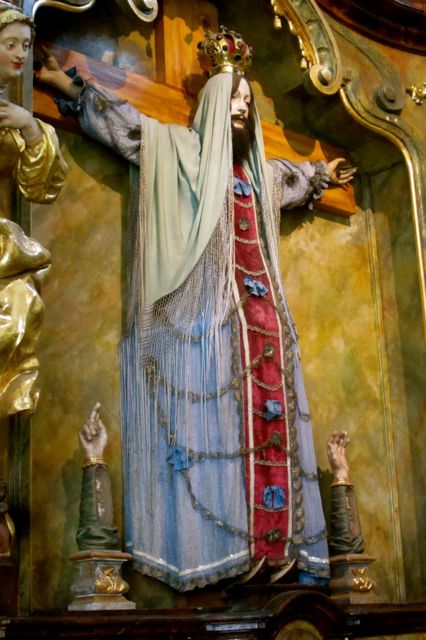
This is Saint Wilgefortis
The image comes from a side chapel in the Loretto, a fantastical palace which was a place of pilgrimage for 17th and 18th century baroque pilgrims with a particular devotion to Mary and her courage. Its cloisters were never wandered by monks as much as by pilgrims lining up to see the chapels and gain courage and faith from their prayers within them.
A beautiful Bohemian princess, she was betrothed by her father to the King of Sicily. For whatevrer reason, she did not want to marry and so prayed that God would rescue her from this fate. The story goes that she grew a beard over night and so was rejected by her betrothed; which was good. Her father was so furious that his plans for wealth from the Mediterranean were foiled that he had his daughter crucified; which was not so good.
It is hard to say what is real, true and factual here. And yet I think that is precisely the point when I pray about this. What is true and what is factual and what is real are very different things. Something happened to her. And if not, then something was bubbling up from people which fabricated her because the people who venerated her needed her to exist. I believed in Santa not because I thought there was a fat man in a red suit who delivered gifts on Christmas Eve, but because my parent’s marriage was a disaster and Christmas was a time in which their focus on my happiness through gifts was an event which so drew them out of their narcism that the family has a few days of peace together. I had a lot to loose by admitting that Santa did not exist. We sometimes do what we must to survive and for a child, a happy family, or at least a content one, is a matter of psychological survival.
“Wilgeforits” may come from the Latin “virgo fortis” (in ancient times in Bavaria, the “W” would have sounded more like a “V” and the “l” more like an “r”) which meant “strong virgin” and her English name “Uncumber” means “escaper.” Was she a person suffering from Polycystic Ovary Syndfrome? Was she a powerful lesbian? Was she a strong celibate, determined to live as she pleased in a male dominated society in which women were married for their father’s or husband’s financial gain? Was she a person with sexual confusion or freedom who simply hit puberty while in a dress? Who knows.
What we do know is that she is the patron saint of troubled marriages and that her following was ginormous perhaps because so many marriages are so very troubled. Her story, whether factual or not, is true and therein lies the issue. What is true is that people will manipulate to get what they want. What is true is that people with power will do to those without power, whatever they want and often get away with it. And what is true is that many people in unhappy marriages need to be able to pray with a story like this. They need to have this story acknowledge their pain and suffering and loss without trying to fabricate an inauthentic happy ending. They need to believe that God listens to our prayers and acts in one way or another – not to inspire relief but rather, to inspire belief. And they need to know that sometimes, when life gets terribly hard because a father or husband is a moron … or worse; they need to know and make some kind of physical act of prayer and pilgrimage which makes real for them the true truth – that they are not alone.
Crucifixion is not a happy ending. Wilgefortis was delivered from one man and still remained within the power of another. But she did not lay back and take it. She prayed. She saw an unhappy future and she prayed.
My personal tastes in spirituality are for a simple, ivory painted room with a small cross and perhaps an icon and a candle; and so this baroque world is foreign to me – even troubling. I pray to God and not through saints. God and I have a conversation. Sometimes it is gentle and sometimes…not. And so venerating saints and bowing and scraping to images is not my way. And yet, as an artist, the visual has power. The Psalms say that our eyes are the lamp of our soul.
When I see this image and think of the many people for whom strength was made available to them because they believed in this saint and in her story, I am reminded that what is factual is not important. What is true is important.
Saint Wilgefortis has her saint’s day on July 20th.

